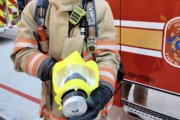WASHINGTON — In the pre-dawn stillness of a D.C. morning, Jeff Horowitz is on the move.
He is running along the trails and river banks of the city long before most residents of the nation’s capital wake up to another steamy summer day.
“I know this is not everyone’s cup of tea, but if you get up pre-dawn and you run, it is cooler,” he says.
It is his time to savor the quiet as the mist lifts off the Potomac, and the sun begins to rise. These early runs are a summer tradition for Horowitz, a D.C. ultra-marathoner and running coach, as well as the author of three books about his beloved sport.
He has run in all kinds of conditions, and says extreme temperatures are doable with the proper adjustments. Horowitz says anyone who exercises outdoors in the heat needs to remember that their body is working hard to keep cool.
“You don’t want to rush that,” he advises, “so a big thing is not to push yourself too fast, too soon.”
Exercise early or late whenever possible, avoiding the hottest parts of the day. And Horowitz — who recently competed in an ultra-marathon in Africa — suggests wearing technical clothing that allows sweat to evaporate.
Cotton t-shirts are not the best choice because they hold onto moisture. Lightweight synthetic gear — in many athletic and sporting goods stores — is a good choice for anyone outdoors on a hot summer day, from joggers to fans at a baseball game.
Getting proper hydration is critical. But runners and those who engage in activities that produce a lot of sweat might want to switch from water to a sports drink to replace the salt and minerals lost in the heat.
Someone who loses too many electrolytes runs the risk of a condition called hyponatremia, in which sodium levels in the blood can get dangerously low. Horowitz says that is why people who do strenuous exercise in sweltering conditions need to be careful not only to drink enough for their body, but to drink the right thing for their workout.
He says anyone who exercises outside — from a distance runner to the couple who walks around the block — needs to slow down their pace and lower their expectations when the weather gets steamy. Fitness experts agree the optimum temperature for outdoor exercise is about 55 degrees, and Horowitz says every degree above that “is going to put a little stress on your body.”
The toll is even greater when the air quality is poor. And even diehard outdoor athletes know there are going to be days when they have to bring their workout inside.
Horowitz says there is nothing wrong with going indoors when there is a code orange or code red air quality alert. And while he knows some people want to be outside even on bad air days, he says that if conditions are potentially dangerous, it is just not worth it.
Follow @WTOP and @WTOPliving on Twitter and WTOP on Facebook.







